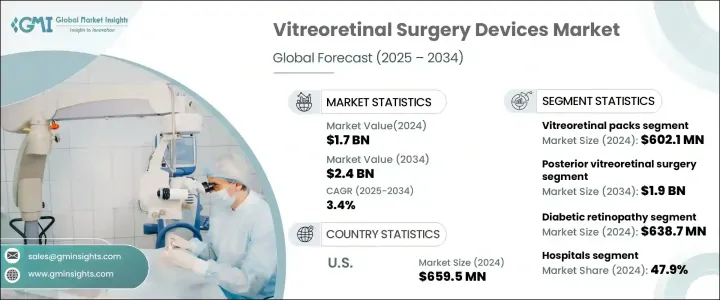
세계의 유리체망막 수술 기기 시장은 2024년에 17억 달러로 평가되었으며, 2025년부터 2034년까지의 CAGR은 3.4%를 나타낼 것으로 전망됩니다.
이 성장은 노화 황반 변성증, 당뇨병 망막증, 망막 박리 등의 망막 질환의 유병률이 상승하고 있는 것이 주요 요인이며, 이러한 질환은 세계적으로 고령화가 진행됨에 따라 일반적으로 되고 있습니다. 또한, 낮은 침습 수술에 대한 선호도 증가가 최첨단 유리체망막 장치에 대한 수요를 밀어 올리고 있습니다. 이러한 수술은 전통적인 수술 방법에 비해 회복 시간이 빨라 환자의 불편함을 줄이는 경향이 있기 때문입니다. 외래 수술 증가는 또한 이러한 추세의 주요 요인이며, 환자와 건강 관리 제공업체는 장기 입원을 피하는 비용 효율적인 신속한 수술을 점점 선호하고 있습니다.

망막질환 치료에 대한 인식을 높이고 이용하기 쉽게 하기 위한 정부 및 민간 부문의 노력이 이 시장의 확대에 크게 기여하고 있습니다. 조기 진단에 중점을 둔 공중 보건 캠페인과 적시 개입의 중요성에 대한 교육은 이러한 고급 수술 치료의 필요성을 더 많은 사람들이 이해하는 데 도움이 됩니다. 게다가 많은 선진국에서 의료보험과 상환 옵션을 이용할 수 있게 됨으로써, 경제적인 장벽이 경감되어 보다 많은 환자가 이러한 필요한 수술을 선택할 수 있게 되었습니다. 그 결과, 유리체망막 수술 기기의 보급을 촉진하는데 있어서, 인지도와 합리적인 가격의 양쪽 모두가 매우 중요한 역할을 하고 있습니다.
| 시장 범위 | |
|---|---|
| 시작 연도 | 2024년 |
| 예측 연도 | 2025-2034년 |
| 시작 금액 | 17억 달러 |
| 예측 금액 | 24억 달러 |
| CAGR | 3.4% |
시장은 다양하며 다양한 제품이 성장에 기여합니다. 주요 부문에는 유리체 수술용 프로브, 유리체망막 팩, 유리체 수술 장치, 조명 장치, 광응고 레이저 및 기타 관련 제품이 포함됩니다. 이 중 유리체망막 팩은 2024년에 6억 210만 달러를 창출해 중요한 부문이 되었습니다. 이 팩은 미리 조립되고 멸균된 기구 및 소모품이 포함되어 있으므로 별도의 조달이나 멸균이 필요 없으며 편의성을 높이 평가됩니다. 이는 시간을 절약할 뿐만 아니라 의료 제공자의 업무 효율성을 높이고 병원 및 클리닉 준비 비용을 절감합니다.
수술 절차의 관점에서 망막 후 유리체 수술 분야는 상당한 성장을 이루려고 합니다. 2034년까지 19억 달러에 이를 것으로 예상되는 이 분야는 고속 유리체 수술 장치의 진보, 수술 중 이미지 강화, 보다 작고 정밀한 기구의 개발에 의해 견인되고 있습니다. 이러한 기술 혁신은 후안부 수술의 효율성과 안전성을 향상시키고 외과의사와 환자에게 매력적인 선택이 되었습니다.
미국의 유리체망막 수술 기기 시장은 2024년 6억 5,950만 달러에 이르렀으며, 2034년까지 연평균 복합 성장률(CAGR) 2.7%를 나타낼 것으로 예측됩니다. 이러한 성장을 뒷받침하는 것은 광간섭 단층계(OCT) 및 실시간 망막 영상처리와 같은 고급 영상처리 기술의 채용이 증가하고 있는 것으로, 이러한 기술은 수술 중 외과의사에 비교할 수 없는 정확도를 제공합니다. 망막 질환에 대한 일반 시민의 인식이 높아지고 진단 도구가 개선됨에 따라 시력을 유지하거나 회복하기 위한 외과적 선택을 요구하는 환자가 늘어나면서 이러한 전문 기기 수요가 더욱 높아지고 있습니다.
The Global Vitreoretinal Surgery Devices Market, valued at USD 1.7 billion in 2024, is set to experience a CAGR of 3.4% from 2025 to 2034. This growth is largely driven by the rising prevalence of retinal diseases, including age-related macular degeneration, diabetic retinopathy, and retinal detachment, which are becoming more common as populations age worldwide. Additionally, the increasing preference for minimally invasive surgical options is pushing the demand for cutting-edge vitreoretinal devices, as these procedures tend to offer faster recovery times and reduced patient discomfort compared to traditional surgical methods. The growing number of outpatient surgeries is also a key factor in this trend, as patients and healthcare providers increasingly favor cost-effective, quick procedures that avoid long hospital stays.

Government and private sector initiatives aimed at raising awareness and improving accessibility to retinal disease treatments are significantly contributing to the expansion of this market. Public health campaigns focused on early diagnosis, along with education about the importance of timely intervention, are helping more people understand the need for these advanced surgical treatments. Moreover, the availability of healthcare coverage and reimbursement options in many developed countries is reducing financial barriers, allowing more patients to opt for these necessary surgeries. As a result, both awareness and affordability are playing pivotal roles in driving the adoption of vitreoretinal surgery devices.
| Market Scope | |
|---|---|
| Start Year | 2024 |
| Forecast Year | 2025-2034 |
| Start Value | $1.7 Billion |
| Forecast Value | $2.4 Billion |
| CAGR | 3.4% |
The market is diverse, with a range of products contributing to its growth. Key segments include vitrectomy probes, vitreoretinal packs, vitrectomy machines, illumination devices, photocoagulation lasers, and other related products. Among these, vitreoretinal packs generated USD 602.1 million in 2024, making them a significant segment. These packs are highly valued for their convenience, as they contain pre-assembled, sterilized instruments and consumables, eliminating the need for separate procurement and sterilization. This not only saves time but also enhances operational efficiency for healthcare providers, reducing preparation costs for hospitals and clinics.
In terms of surgical procedures, the posterior vitreoretinal surgery segment is poised for substantial growth. Expected to reach USD 1.9 billion by 2034, this segment is driven by advancements in high-speed vitrectomy machines, enhanced intraoperative imaging, and the development of smaller, more precise instruments. These innovations have improved the efficiency and safety of posterior segment surgeries, making them a more appealing option for surgeons and patients alike.
In the U.S., the vitreoretinal surgery devices market reached USD 659.5 million in 2024 and is projected to grow at a CAGR of 2.7% through 2034. This growth is fueled by the increasing adoption of advanced imaging technologies, such as optical coherence tomography (OCT) and real-time retinal imaging, which offer surgeons unparalleled precision during procedures. As public awareness of retinal diseases increases and diagnostic tools improve, more patients are seeking surgical options to preserve or restore their vision, further driving demand for these specialized devices.